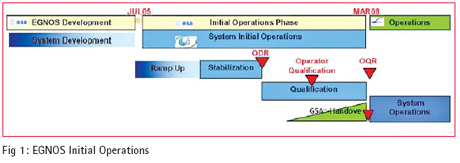| GNSS | |

Understanding EGNOS
|
MELANIE VRITSCHAN, UMBERTO GUIDA, JON WESTBROOK
|
||||
|
THIS paper describes of the activities performed by the European Satellite Services Provider (ESSP) and its partners in the establishment of the EGNOS system operations organization, the implementation and utilization of the operations processes and procedures and the operations products baseline as well as describing the management processes used within EGNOS operations with respect to preparation for Safety of Life Services. The activities required to ramp up, stabilize and qualify the EGNOS operations baseline in the context of introducing an EGNOS Safety of Life service are highlighted and their inputs towards the EGNOS certification process are further presented and discussed. Background and objectivesThe European Satellite Services Provider (ESSP) has been created in 2001 to operate the EGNOS system and provide Safety of Life Services for different user communities. The EGNOS system is providing wide area differential corrections and integrity information to the European Satellite Navigation Community, delivering enhanced performances for users with demanding navigation requirements. The current period of EGNOS operations is entitled the “EGNOS Initial Operations Phase” and started in July 2005 and is due to complete in March 2008. It is managed under a European Space Agency (ESA) contract by a consortium coordinated by the ESSP. This phase prepares and facilitates the handover of operations management responsibilities from ESA to the European GNSS Supervising Authority (GSA) and the EGNOS Operator. The objectives of the Initial Operations Phase are: to increase ESSP’s staff and resources to fully support EGNOS Safety of Life Operations; to transfer knowledge and operation experience from the European Space Agency to the European Satellite Services Provider; establish, test and validation of the operations and procedures designed to stabilize EGNOS Operations to a level of performances commensurate with the system requirements. The baseline of the EGNOS Operations Management consists mainly of organization, staff, processes, procedures and tools. A dedicated EGNOS Operations Qualification Program has been designed to qualify the EGNOS Operation baseline for the support of safety-critical applications; such program runs during the whole Initial Operations Phase. Specific aspects of the EGNOS Operations Management are: * the establishment of management processes for the use of EGNOS applicable to the whole system EGNOS has entered the qualification phase of Initial Operations, which is the final part of the operations qualification program. It demonstrates that the EGNOS operations organization, staff, procedures and documentation, can support EGNOS operations performances. The qualification phase concludes with the Operations Qualification Review (OQR) and the Safety of Life service provision will follow this milestone. As such, in the furtherance of the objective to use EGNOS for the full support of Safety of Life operations, the availably of the EGNOS Signal-in- Space has been progressively increased. All EGNOS ground components, such as the 34 Ranging and Integrity Monitoring Stations (RIMS), the 4 Mission Control Centers (MCCs), the 2 Support Facilities, the 6 Navigation Land Earth Stations (NLES), the EGNOS Wide Area network (EWAN) and the relative EGNOS Operations Team are now under ESSP contractual and technical control. |
||||














 (No Ratings Yet)
(No Ratings Yet)





